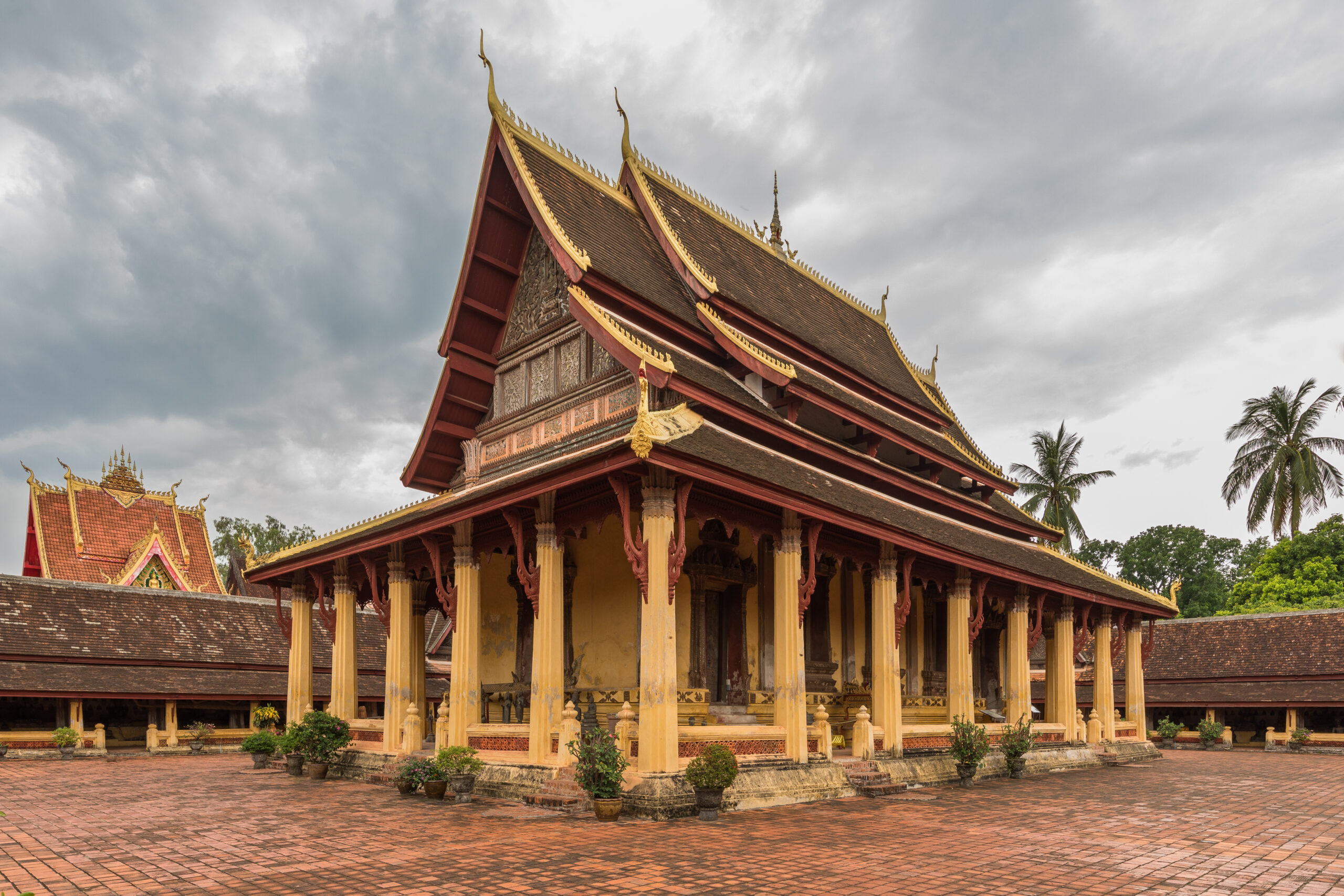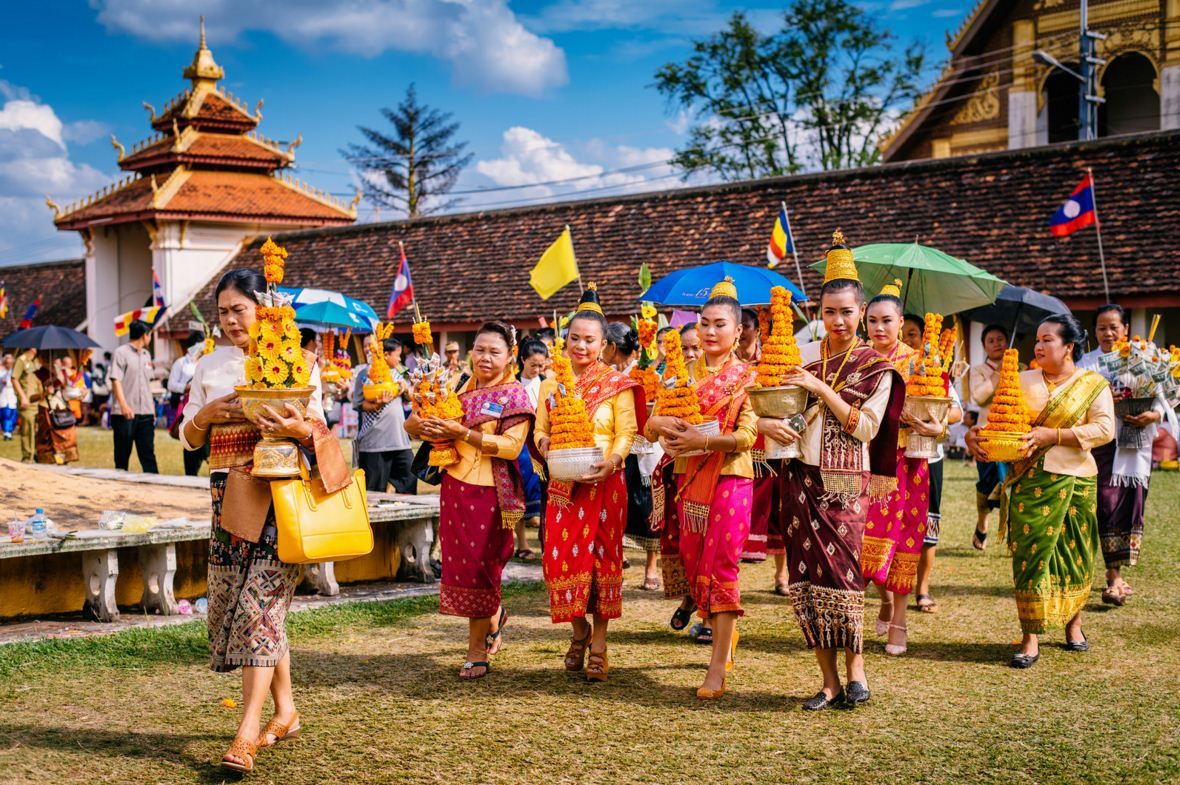1. Overview
Patuxai, also known as the Victory Monument, is a significant landmark in Vientiane, Laos. The monument was built to honor those who fought for the country’s independence from French colonial rule. Its design is inspired by the Arc de Triomphe in Paris, with a unique blend of Lao and French architectural styles.
Name: Patuxai (Victory Monument)
Location: Vientiane, Laos
Coordinates: Approximately 17.9706° N, 102.6186° E
Best visited: While exploring Vientiane’s historical landmarks or seeking panoramic city views.
2. History of the Place
Patuxai holds great historical and cultural significance in Laos:
- Construction Period: Built between 1957 and 1968 using cement meant for an airport runway.
- Original Name: Initially named Anousavary (Monument to the Fallen), dedicated to those who fought for independence.
- Architectural Design: Designed by Lao architect Tham Sayasithsena, blending Western and traditional Lao styles.
- Symbolism: The monument features five towers representing the five Buddhist principles.
- Royal Significance: It was constructed to honor the Laotian people’s fight against French colonial rule.
- Cultural Features: The monument is adorned with Hindu and Buddhist symbols, including lotus motifs, kinnari (mythical creatures), and nagas (serpents).
- Destruction and Restoration: Partially damaged in the 1970s during political unrest but restored after the establishment of the Lao PDR.
- Height: Stands 49 meters tall, with seven levels offering spectacular views of the city.
- Renaming: After 1975, the monument was renamed Patuxai, which translates to “Victory Gate.”
- Access: Visitors can pay a small fee to climb to the top for 360-degree views of Vientiane and the surrounding area.
3. Location
4. What Makes “Patuxai” Popular?
Patuxai attracts visitors due to its historical significance, stunning design, and panoramic views.
- Cultural Importance: A symbol of independence and the spirit of the Lao people.
- Architectural Marvel: A mix of Lao, Khmer, and French influences that make it stand out in Vientiane’s skyline.
- Scenic Views: The monument offers some of the best panoramic views of the city and surrounding areas, especially at sunset.
5. Overall Ratings (1 to 5 Stars)
Patuxai is widely praised for its cultural and architectural significance, as well as the stunning city views it provides.
Overall Rating: ⭐⭐⭐⭐⭐ (5/5)
Cultural Significance: ⭐⭐⭐⭐⭐ (5/5)
Authenticity: ⭐⭐⭐⭐⭐ (5/5)
Atmosphere & Environment: ⭐⭐⭐⭐☆ (4/5)
Accessibility: ⭐⭐⭐⭐⭐ (5/5)
Tourist Friendliness: ⭐⭐⭐⭐⭐ (5/5)
6. Weather
Vientiane experiences a tropical climate, with distinct wet and dry seasons.
Best Time to Visit: November to February (cooler, dry season)
Temperature Range: 25–35°C (77–95°F)
Wet Season: May to October
Rain Gear: Recommended during the wet season.
7. Nearest Five Hotels
For visitors seeking accommodation near Patuxai, here are five nearby options:
- Sabaidee@Lao Hotel: Comfortable rooms with a central location.
- Vientiane Plaza Hotel: A short distance from Patuxai with modern amenities.
- Green Park Boutique Hotel: Offers a blend of contemporary and traditional styles.
- City Inn Vientiane: Affordable and conveniently located for tourists.
- Ibis Vientiane Nam Phu: Budget-friendly and centrally located.
8. Timings
Patuxai is open for visitors daily.
Opening Hours: 8:00 AM – 5:00 PM
Best Time to Visit: Early morning or late afternoon for better lighting and fewer crowds.
9. Time Required to Visit
A visit to Patuxai can be a quick stop or a longer experience depending on interest in the views and history.
Visit Duration: 1 hour
Ideal for: History enthusiasts, photographers, and those seeking a panoramic view of the city.
10. Entry Fees & Ticket Booking Details
There is an entry fee to access the top of Patuxai for panoramic views.
Entry Fee: 3,000 LAK (approximately $0.30)
Booking: Not required for general visits.
11. Things to See & Do
Visitors can explore the monument’s seven levels, take in the views from the top, and enjoy the surrounding Patuxai Park.
- Explore: The monument’s detailed carvings, sculptures, and Buddhist and Hindu motifs.
- Photography: Capture the stunning architecture and panoramic views of Vientiane.
- Relax: Walk through the park and enjoy the fountains and green spaces.
12. Best Time to Visit
The best time to visit is during the dry season, with cooler temperatures and clearer skies for better views.
Best Time: November to February (cooler, dry season)
Time of Day: Early morning or late afternoon to avoid crowds and to enjoy the best lighting.
13. Nearest Parking Spots
There are various parking spaces around Patuxai, including both street parking and public lots.
Street Parking: Available near the monument.
Public Parking: Located in Patuxai Park and surrounding areas.
Alternative: Tuk-tuks and bicycles are also convenient for getting around the area.
14. Tips for Visitors
- Dress Modestly: As a landmark of historical and cultural significance, visitors are encouraged to dress appropriately.
- Climb to the Top: Don’t miss the chance to climb to the top for amazing panoramic views of Vientiane.
- Photography: Be mindful when taking photos, especially during local ceremonies or events.
- Carry Water: Bring water, especially if visiting during the warmer months.
15. How to Reach the Place
Patuxai is located in the heart of Vientiane and is easily accessible by foot, tuk-tuk, or bicycle.
By Tuk-Tuk: Convenient and affordable for short trips.
By Bicycle: A great way to explore the city at your own pace.
By Foot: Easily accessible from nearby landmarks.
Taxi: Available for longer trips.
16. Nearby Attractions to Combine for the Visit
Consider visiting other landmarks near Patuxai to enrich your experience of Vientiane.
- That Luang Stupa: The most important religious monument in Laos.
- Mekong Riverfront: A scenic area for shopping, dining, and walks along the river.
- Wat Si Saket: The oldest surviving temple in Vientiane.
- COPE Visitor Centre: Learn about the history of unexploded ordnance in Laos.
- Lao National Museum: Discover the history and culture of Laos.



